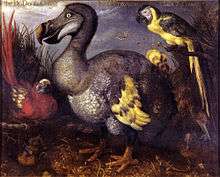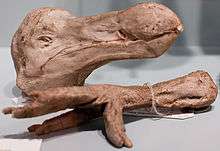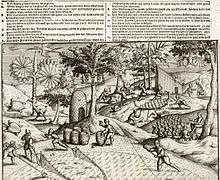Wikijunior:Extinct Birds/Dodo
< Wikijunior:Extinct Birds
The Dodo (Raphus cucullatus) is a flightless, extinct bird which inhabited the island of Maritius, and island 1,200 miles down the African Subcontinent. Nothing is much known about this bird since the only things we have left of the Dodo is pictures and fossils of the bird's bones.
How was the Dodo found?
It is believed, by Extinct Birds, that the Dodo was found by a Dutch Sailor in 1598 in the island of Mauritius. The name, Dodo, means "Ugly, Disgusting Bird". It was named that because of the appearance. Many believe, however, that the Dodo only habitat was in the island of Mauritius, so Dutch explorers may have been going through the African subcontinent 1,000 miles below.
How is the Dodo extinct?


The main reason why the Dodo is extinct is because it was a real target for food. Not only alive were they killed, but some of their eggs were eaten. Usual Dodo eggs were main food for vultures and coyotes. Which led up to the big extinction. It is to be believed that the last dodo was spotted, or seen, in around the 1660s or the early 1670s. There have also been various other animals that are extinct from Maritius
What were the main predators?

The main predators are mankind. Hence the fact that they are extinct, the dodos became extinct because of Dutch sailors hunting them for food, and as mentioned above that the Dodo eggs are usual prey to many birds or other land animals who were on Mauritius, preventing more dodos from hatching. The dodos became prey of which many of the Dutch sailor's animals, such as pigs, monkeys, and rats.
Recent News
- Source
- "Extinct Dodo Related to Pigeons, DNA Shows" - Hillary Mayell, for National Geographic News, February 28, 2002.
- Summary
The famous extinct Dodo, which has a pitiful reputation as a stupendously overweight idiot of a bird that couldn't even fly, has DNA related to the Pigeon. Which DNA examinations show.
- Quotes
"Island taxa such as the dodo and solitaire often represent extreme examples of evolution—and if we want to examine how we, or the life around us, evolved then such animals are very educational, By examining island birds we can investigate how evolution works—because extreme examples are often the best views of how something works"
--Alan Cooper, a zoologist at the University of Oxford and one of the co-authors of the study.
Preserves of Dodos
The only thing we have which traces the Dodo's history is pictures of the bird and bones of the bird, which is preserved mostly in museums. More are come to find, but and most will be carefully examined by special scientists.
Sources
- http://www.google.com/search?q=How+was+the+Dodo+Bird+found%3F&ie=utf-8&oe=utf-8&aq=t&rls=org.mozilla:en-US:official&client=firefox-a&channel=fflb (search results at google)
- Search results at yahoo.com
- Search results at Bing.com (search results at bing)
- Wiki Answers - What is the dodo bird's predator?
- Wikiversity has more images than this wikibooks page has. If you would like more images here, please copy the image and upload it to commons.